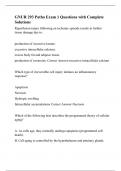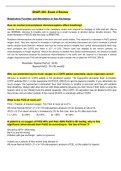GNUR 293
Loyola University Chicago
Page 3 out of 28 results
Sort by
GNUR 293 Exam 3 Vascular Pathophysiology Questions with complete solutions.
GNUR 293 Heart failure Questions with complete solutions.
GNUR 293 Loyola University Chicago -GNUR 293 Patho Exam 1 Questions with Complete Solutions
GNUR 293 - Exam 4 Study Guide & Review.
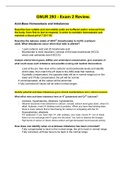
-
GNUR 293 - Exam 2 Review.
- Exam (elaborations) • 13 pages • 2021
-
- $14.49
- + learn more
GNUR 293 - Exam 2 Review/GNUR 293 - Exam 2 Review. Acid-Base Homeostasis and Imbalances Describe how volatile and nonvolatile acids are buffered and/or removed from the body, from first to last to respond, in order to maintain homeostasis and maintain a blood pH of 7.35-7.45. Describe the balance (ratio) of HCO3- (bicarbonate) to H2CO3 (carbonic acid). What imbalances occur when that ratio is altered? - 1-part carbonic acid and 20 bicarbonate acid - Bicarbonate is most important, con...
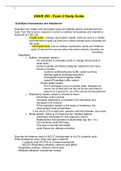
-
GNUR 293 - Exam 2 Study Guide
- Exam (elaborations) • 17 pages • 2021
-
- $12.99
- 1x sold
- + learn more
GNUR 293 - Exam 2 Study Guide/GNUR 293 - Exam 2 Study Guide Acid-Base Homeostasis and Imbalances Describe how volatile and nonvolatile acids are buffered and/or removed from the body, from first to last to respond, in order to maintain homeostasis and maintain a blood pH of 7.35-7.45. o Volatile acids: undergo vaporization rapidly. Carbonic acid is a volatile acid that forms inside our body from carbon dioxide and is excreted via the lungs. o Nonvolatile acids: Cannot undergo vaporiza...
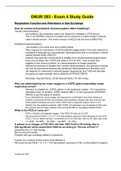
-
GNUR 293 - Exam 4 Study Guide.
- Exam (elaborations) • 29 pages • 2021
- Available in package deal
-
- $13.99
- + learn more
GNUR 293 - Exam 4 Study Guide/GNUR 293 - Exam 4 Study Guide. Respiratory Function and Alterations in Gas Exchange How do central and peripheral chemoreceptors affect breathing? Central chemoreceptors: - are located in the medullary center and respond to changes in CO2 and ph. - This is our NORMAL stimulus to breathe and is caused by a small increase in arterial carbon dioxide tension. This small increase in PaCO2 tells the body to BREATHE. Peripheral chemoreceptors: - are locat...

-
GNUR 293 - Exam 3 Study Guide.
- Exam (elaborations) • 17 pages • 2021
-
- $12.99
- 2x sold
- + learn more
GNUR 293 - Exam 3 Study Guide/GNUR 293 - Exam 3 Study Guide. Alterations in Blood Flow How do pressure, resistance, velocity, turbulence, compliance and Starling’s forces impact blood flow? Pressure: Blood moves from high pressure (systemic arteries) to low pressure (veins) More pressure = increased flow Increased Blood = Increased Pressure Resistance: resistance that must be overcome to push blood through the circulatory system; movement of blood through the vascular system is...

Do you wonder why so many students wear nice clothes, have money to spare and enjoy tons of free time? Well, they sell on Stuvia! Imagine your study notes being downloaded a dozen times for $15 each. Every. Single. Day. Discover all about earning on Stuvia



